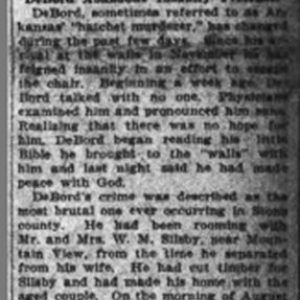calsfoundation@cals.org
Quadruple Execution of 1923
Four inmates were executed on February 2, 1923, at the Arkansas State Penitentiary. This event marked the largest number of executions carried out by the state in a single day up to that point. Three were convicted of a murder committed in Ashley County, while the fourth was executed for two murders committed in Stone County.
Ira Culp, a farmer near Wilmot (Ashley County), was murdered on the night of May 11, 1922. On the night of the murder, a group of horseback men from Bonita, Morehouse Parish, Louisiana, approached the Culp home. (Bonita is approximately seven miles south of the Arkansas state line.) While the motive for the crime is unclear, it is apparent that the men knew Culp, a native of Illinois who lived alone on the farm while his family lived in Wilmont. When the men called him out onto the porch, Culp emerged wearing his sleeping clothes. Ben Richardson fired a gun at Culp, missing him. Culp returned fire, also missing. Another shot from Richardson hit Culp, who then collapsed on the porch. Ben Richardson, his brother Duncan Richardson, and F. G. Bullen pulled Culp into the house. One report claimed that the men used an axe to sever Culp’s limbs from his torso, and another claimed that he was placed on a bed soaked with kerosene. The house was burned, and his body was found several days later in the ashes. A fourth man named Filmore Gaul was present at the crime but later testified that he did not participate.
The murder remained unsolved for several months. Eventually, the Richardson brothers and Bullen were charged with the crime and convicted on September 6, 1922. While the three men never made a public statement about their motive, authorities in Ashley County said that Culp had enclosed a large area that previously served as a public grazing area, enraging a number of locals.
The fourth man convicted of murder and executed the same day was Will Debord. A timber worker near Mountain View (Stone County), Debord separated from his wife and moved in with his boss, William Silsby, and his boss’s wife. On August 23, 1922, Debord attacked William Silsby in bed with a hatchet. After killing Silsby, Debord tracked down Silsby’s wife as she hid in a chicken coop and killed her.
After the murders, Debord obtained a job nearby and worked for about a week before his crime was discovered. After being confronted with the bodies, he confessed and led authorities to money he stole from the Silsby home. He claimed that William Silsby attacked him after an argument over money, and he was forced to kill both in self-defense. Convicted of the crime, Debord claimed to be insane to avoid execution but was deemed to be sane by a physician.
The night before the executions, in an effort to spare his brother and Bullen, Duncan Richardson claimed that he alone carried out the murder of Culp. The ploy did not work, and the executions proceeded as scheduled. All four of the men willingly walked to their execution and did not resist. The order of the executions was not set before they began, and the warden selected Ben Richardson to be the first to die. Other sources list Duncan Richardson, age twenty-nine, as the first to be executed, sitting in the electric chair at 7:00 a.m. F. G. Bullen, age fifty, was the third man executed. After that execution, Bullen’s body remained in the chair for five minutes before being placed in a casket. The undertaker noticed that Bullen continued to breathe and refused to take the body. Bullen was placed back into the chair and electrocuted again. Twenty-two-year-old Will Debord was the last to sit in the chair, at 8:02 a.m.
The bodies of the Richardson brothers and Bullen were taken to Chicot County for burial. State senator Harvey Parnell arranged for the burial in that county to allow the parents of the Richardson brothers to visit the graves.
The Arkansas Department of Correction incorrectly lists the executions of Duncan Richardson and Bullen as taking place on February 22 rather than the correct date of February 2. The next mass execution took place on February 12, 1926, when four inmates convicted of murder in Ouachita County were sent to the electric chair.
For additional information:
“‘Dead Convict’ Moves After Death Shock.” New York Times, February 3, 1923.
“Four Executed in 67 Minutes Time.” Arkansas Gazette, February 3, 1923.
“Four Will Die in the Chair Today.” Arkansas Gazette, February 2, 1923.
David Sesser
Henderson State University


 Quadruple Execution Article
Quadruple Execution Article 



Comments
No comments on this entry yet.